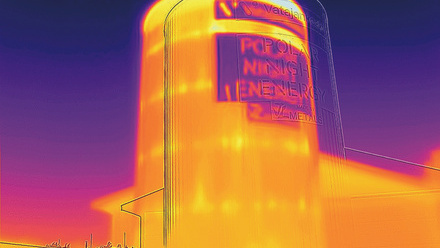Wireless technology that controls magnetism
A team of scientists based in Barcelona, Spain, says it can wirelessly generate and manipulate the magnetism of thin cobalt nitride (CoN) film layers – which were initially non-magnetic – by voltage. This could facilitate biomedical and computer applications that do not rely on wiring.

Controlling magnetism using voltage instead of electric currents could improve energy efficiency in many devices, since currents heat up circuits. But most research carried out to date has involved applying voltages through electrical connections directly on the materials.
The multi-institution team claims it is the first to modify the CoN layer’s magnetic properties through wireless magneto-ionics, inducing voltage indirectly to non-magnetic materials.
Researchers from Universitat Autònoma de Barcelona, led by Jordi Sort in the physics department, and the Institute of Materials Science of Barcelona (ICMAB), were assisted by the Institute of Microelectronics of Barcelona and the Alba Synchrotron.
They first fabricated non-magnetic, 50nm-thin CoN films, which are configured as horizontal and vertical bipolar electrochemistry (BPE) samples.
To obtain the correct crystallinity of the film layers, the team tuned several parameters, including growing the films by magnetron sputtering at room temperature, as reported in a paper on Wireless magneto-ionics: voltage control of magnetism by bipolar electrochemistry, published in Nature Communications.
The paper notes how, for the horizontal BPE samples, films are deposited using a 50% nitrogen/50% argon atmosphere on [100]-oriented silicon substrates that are 8×8mm lateral size and 0.5mm thick. They are pre-coated with 20nm of titanium and 60nm of gold. The total pressure is then set at a value of almost 0.4Pa for sputtering.
Importantly, the lateral dimensions are changed for the vertical BPE samples, notes the study. For these, layered structures of titanium (20nm) / gold (60nm) / silicon of lateral dimensions of 8×20mm are used as the substrates for depositing 50nm-thick CoN films, but the same sputtering conditions are applied.
The films are then immersed in a liquid electrolyte solution that is made up of 0.1M potassium iodide (KI) electrolyte and a propylene carbonate (PC) solvent to enable ionic conductivity.
The paper reports, 'Anhydrous PC was used as a solvent to prevent CoN hydrolysis in an aqueous media, which would yield cobalt oxides. The presence of KI offers the required conductivity of the electrolyte, and it also supports the complementary oxidation reaction at the driving anode and the induced anode at the biopolar electrodes.'
Finally, the samples are placed next to a pair of vertical planar platinum plates, which act as electrodes and create an electric field around the BPE samples. The voltage is then applied via the two plates, without connecting any wires directly to the samples.
An induced electric field is generated that causes the nitrogen ions to leave the CoN. The result is the sample changes from a non-magnetic to magnetic, essentially metallic, Co state.
The researchers add that the strength of the sample’s magnetic properties varies depending on the voltage applied, the actuation time and its orientation in relation to the electric field imposed.
'The volatility of the magnetic property changes observed in horizontal devices was a bit daunting…but we soon realised we could avoid this problem by moving on to vertically configured devices,' says Sort.
'The latter not only gives us non-volatile magnetic signal changes but also enriches the overall discussion of the study.'
According to ICMAB researcher Professor Nieves Casañ-Pastor, the wireless magnetic control achieved is not exclusive to CoN. 'These protocols can be extrapolated to other materials to control other physical properties wirelessly, such as superconductivity, memristor control, catalysis, or transitions between insulator and metal, as well as wireless electrodes for neuronal electrostimulation.'







